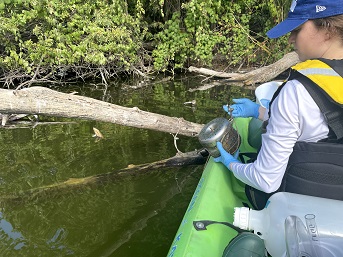Study examines feasibility of using human cyanotoxin thresholds to protect aquatic life

SCCWRP and its partners have completed an initial investigation into whether existing cyanotoxin thresholds intended to protect the health of humans exposed to cyanotoxins in freshwater systems also could be used to protect the health of fish, invertebrates and amphibians.
The two-year study, published this summer by the journal Science of the Total Environment, found that existing, national health-based toxicity levels should be adequate for protecting aquatic life from acute exposure to a major class of cyanotoxins known as microcystins. These same levels, however, may not fully protect aquatic life from chronic exposure.
The study, which involved examining cyanotoxin data from more than 150 aquatic life toxicity studies, is one of the first efforts to examine whether existing cyanotoxin thresholds for human health protection also could be applicable to aquatic life. Although thresholds already exist to protect humans exposed to toxins via recreational water-contact activities, comparable thresholds for aquatic life have not yet been developed.
Cyanobacterial blooms, which can contaminate freshwater and marine systems with toxins that harm both humans and aquatic life, are becoming more frequent and severe across California as waters warm in response to climate change. Both the U.S. Environmental Protection Agency and California have developed concentration-based cyanotoxin trigger values to protect humans from recreational-contact exposure.
The study found that while both the EPA and California trigger values would be adequate for protecting aquatic life from acute exposure to microcystins, protection from chronic effects would depend on whether the EPA’s trigger values vs. the most stringent of California’s tiered trigger values is applied.
The management need to protect humans as well as aquatic life from cyanotoxin exposure is outlined in a comprehensive statewide strategy developed by the State Water Board earlier this year. The proposed strategy, published earlier this year, provides a long-term roadmap for how California could boost its capacity to monitor the growing threat posed by freshwater harmful algal blooms (HABs).
In late October, SCCWRP briefed several key agencies, including EPA and California’s Office of Environmental Health Hazard Assessment (OEHHA), on the findings of its initial investigation, which is known as a meta-analysis.
If water-quality managers pursue development of cyanotoxin thresholds for aquatic life, the researchers recommend expanding toxicity analyses to study more classes of cyanotoxins. SCCWRP and its partners initially studied four prevalent classes of cyanotoxins – microcystins, cylindrospermopsin, anatoxin-a and saxitoxin – but found that there are only enough data to draw conclusions about microcystins.
The researchers also recommend gathering more data on the sub-lethal effects of chronic exposure. Although chronic exposure can lead to impaired development and reproduction in aquatic life, as well as mortality, the researchers found that chronic exposure has not been nearly as extensively studied as acute exposure.
Already, SCCWRP has convened a working group of international experts on cyanobacteria, ecotoxicity and risk assessment to help the research community identify the quality-assurance criteria necessary to improve consistency for future experimental and reporting parameters for cyanotoxin toxicity studies, as well as to assess the health risks of exposure for aquatic organisms. The workgroup began meeting in late October.
For more information, contact Dr. Alvina Mehinto.
More news related to: Emerging Contaminants, Eutrophication, Harmful Algal Blooms, Top News